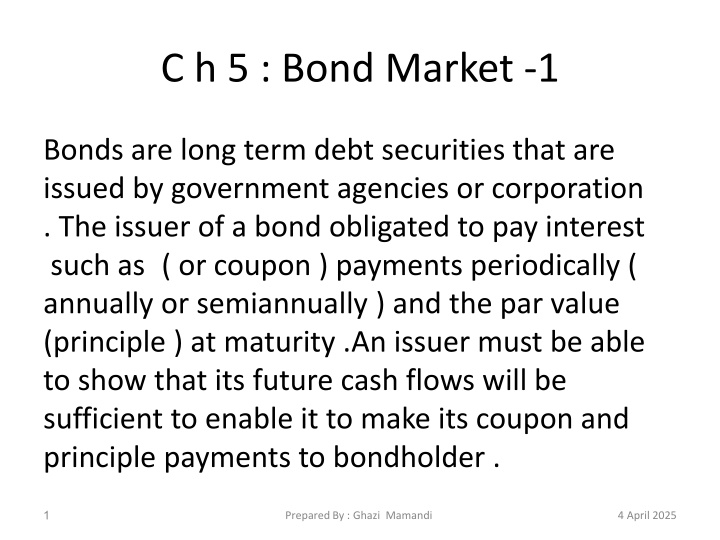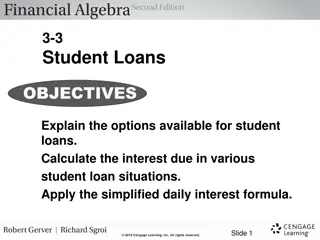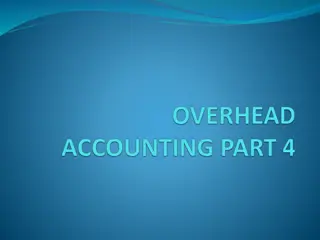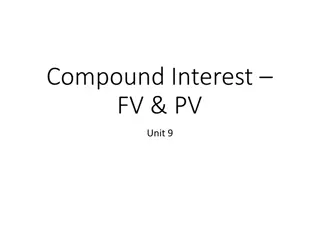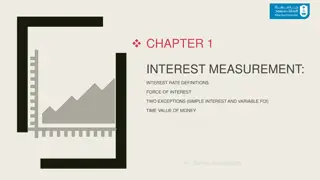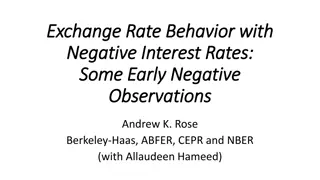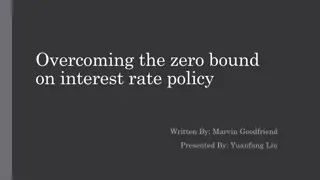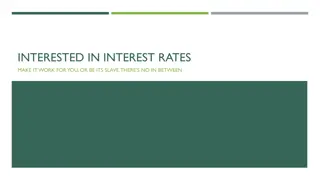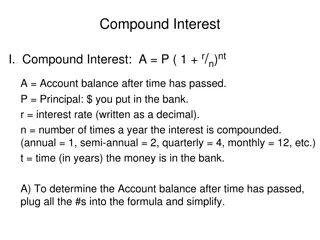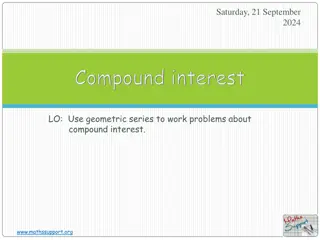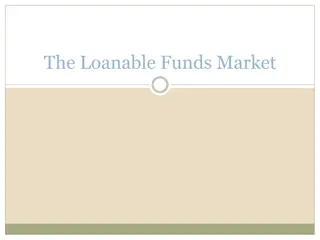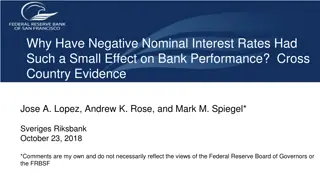Risk and Term Structure of Interest Rates
factors impacting interest rate fluctuations and theories explaining rate variation across maturities. Explore default risk, liquidity, tax considerations, and bond ratings by agencies like Moody's and Standard & Poor's.
Download Presentation

Please find below an Image/Link to download the presentation.
The content on the website is provided AS IS for your information and personal use only. It may not be sold, licensed, or shared on other websites without obtaining consent from the author.If you encounter any issues during the download, it is possible that the publisher has removed the file from their server.
You are allowed to download the files provided on this website for personal or commercial use, subject to the condition that they are used lawfully. All files are the property of their respective owners.
The content on the website is provided AS IS for your information and personal use only. It may not be sold, licensed, or shared on other websites without obtaining consent from the author.
E N D
Presentation Transcript
C h 5 : Bond Market -1 Bonds are long term debt securities that are issued by government agencies or corporation . The issuer of a bond obligated to pay interest ( or coupon ) payments periodically ( such as annually or semiannually ) and the par value (principle ) at maturity .An issuer must be able to show that its future cash flows will be sufficient to enable it to make its coupon and principle payments to bondholder . 1 Prepared By : Ghazi Mamandi 4 April 2025
Background of Bonds Bonds are classified according to the type of issuer . Treasury Bonds are issued by the U.S government , federal agency bonds are issued by federal agencies , Municipal bonds are issued by state and local government , corporate bonds are issued by corporation .Most bonds have maturities of between 10 and 30 years .Bonds are classified by the ownership structure as either bearer or registered bonds. Bearer bonds require the owner to clip coupons attached to the bonds and send them to the issuer to receive coupon payments. 2 Prepared By : Ghazi Mamandi 4 April 2025
Background of Bonds Registered Bonds require the issuer to maintain records of who owns the bond and automatically send coupon payment to the owner. Bonds are issued in the primary market through a telecommunication network. 3 Prepared By : Ghazi Mamandi 4 April 2025
How bond market make possible to flow the fund. Spending on government program U.S Treasury Purchase of Mortgage originated by banks Federal Agencies Household and institutional investors Spending on state and local government Municipalities Spending to expand operations Corporation 4 Prepared By : Ghazi Mamandi 4 April 2025
How bond market make possible to flow the fund 1-The U.S treasury issue bond and use to support deficit spending on government programs. 2- Federal agency issue bonds and use it to buy mortgage that originated by banks . 3- corporation issue bonds and use it to expand their operation. 5 Prepared By : Ghazi Mamandi 4 April 2025
Institutional use of Bond Market All types of financial institution participate in the bond market .Commercial Banks ,finance companies issue bonds in order to raise capital to support their operation .Commercial banks, saving institution ,bond mutual fund, insurance companies and pension fund are investors in the bond markets . 6 Prepared By : Ghazi Mamandi 4 April 2025
Types of Bonds Bonds are securities that represent a debt owed by the issuer to the investors . Bonds obligate the issuer to pay a specified amount at a given date, generally with periodic interest payment. The par , face , or maturity value of the bond is the amount that the issuer must pay at maturity. The rate is usually fixed for the duration of the bond and does not fluctuate with market interest rates. 7 Prepared By : Ghazi Mamandi 4 April 2025
Treasury Notes and Bonds The U.S treasury issue notes and bonds to finance the national debt. The difference between a note and a bond is that notes have an original maturity of 1 to 10 year while bonds have an original maturity of 10 to 30 years. Federal government notes and bonds are free of default risk because the government can always print money and raise tax to pay off the debt if necessary. 8 Prepared By : Ghazi Mamandi 4 April 2025
Treasury Bond Interest Rate Treasury Bond have very low interest rates because they have no default risk. Investors in treasury bonds have found themselves earning Less than the rate of inflation in some years. Most of time the interest rate on treasury notes and bonds is above that the money market securities because of interest rate risk. 9 Prepared By : Ghazi Mamandi 4 April 2025
Bonds Yield The yield on the bond may depend on whether it is viewed from the perspective of the issuer of the bond who obligated to make payments on the bond until maturity or from the perspective of the investors who purchase the bond 10 Prepared By : Ghazi Mamandi 4 April 2025
Risk structure of interest rates Interest rates on different categories of bonds differ from one another in any given year. First : the interest rate on municipal bonds are higher than those on Treasury bills. The interest on corporate bonds is higher than governmental bonds since the default risk is higher in corporate bonds. 11 Prepared By : Ghazi Mamandi 4 April 2025
Default Risk One characteristic of a bond that influence its interest rate is its risk of default , which occurs when the issuer of the bond is unable or unwilling to make interest payments when promised or pay off the face value when the bond matures. The default risk on its bond would therefore be quite high , by contrast U.S treasury bonds have usually been considered to have no default risk. 12 Prepared By : Ghazi Mamandi 4 April 2025
Default Risk Because the federal government can always increase taxes to pay off its obligation. Bonds like these with no default risk are called default free bonds .The spread between the interest rate on bonds with default risk and default free bonds , both of the same maturity called the risk premium . 13 Prepared By : Ghazi Mamandi 4 April 2025
Bond rating by Moody's and standard and poor Moody's Standard and poor's Example of corporations Descriptions General Electric , Exxon Mobile Aaa AAA Highest quality ( lowest default risk ) Aa AAA High quality Shell Canada A A Upper medium grade McDonald Best Buy, Daimler Chrysler Baa BBB Medium grade Ba BB Lower medium grade Hilton Hotel Ford Motor, General Motor B B Speculative Caa CCC Poor ( high default risk ) Atlantis plastic C D Highly speculative Delta Air lines 14 Prepared By : Ghazi Mamandi 4 April 2025
Participation of financial institution in Bond market Financial Participation in bond Market Institution Commercial Banks and saving and loan association Purchase bonds for their asset portfolio Sometimes place municipal bonds for municipalities Sometimes issue bonds as a source of secondary capital Finance companies Commonly issue bonds as a source of long term funds . Use funds received from the sale of shares to purchase bonds some bonds mutual funds specialize in particular type of bonds . Mutual funds make possible bond trading by matching up buyers and sellers of bond in the secondary market Brokerage firms Investment bank firm Place newly issued bonds for government and corporation . Purchase bonds for their asset portfolio Insurance companies Purchase bonds for their asset portfolio Pension fund 15 Prepared By : Ghazi Mamandi 4 April 2025
Treasury and federal Agency Bonds The U.S treasury commonly issue treasury notes or Treasury Bonds to finance federal Government expenditure . The minimum denomination for treasury notes or bonds is $1000 . The key differences between a note and a bond is that note maturities are less than 10 years ,whereas bond maturities are 10 years or more. The treasury has issued 30 years Treasury Bond and 10 years Treasury bond to finance the U.S budget deficit . 16 Prepared By : Ghazi Mamandi 4 April 2025
Municipal bonds Municipal bonds are securities issued by local , country and the state government to finance public interest project such school , utilities and transportation systems . Municipal bonds that are issued to pay for essential public project are exempt from federal taxation . This allow the municipally to borrow at a lower cost because investors will be satisfied with lower interest rates on tax- exempt at a lower bonds. 17 Prepared By : Ghazi Mamandi 4 April 2025
Corporate Bonds When large corporation need to borrow funds for long period of time, they may issue bonds. Most corporate bonds have a face value of $1000 and pay interest semiannually ( Twice per year ) . Most are also callable . The degree of risk varies widely among issues because the risk of default depends on the company's health , which can be affected by a number of variables. 18 Prepared By : Ghazi Mamandi 4 April 2025
Corporate Bond Corporate Bond are long term debt securities. They promise the owner coupon payment (interest )on a semiannual basis. the minimum denomination is $1000 . Their maturity is typically between 10 and 30 years. Although Boeing , chevron and other corporation have issued 50 years bond and Disney , Coca Cola company issued 100 years bond. The interest paid by corporations to investors is tax deductable to the corporation. Which reduce the cost of financing the debt. 19 Prepared By : Ghazi Mamandi 4 April 2025
Corporate Bond offering Corporate Bonds can be placed with investors through a public offering or a private placement. 1- public offering : corporations commonly issue bonds through public offering. A corporations that plans to issue bonds hires an investment bank to underwrite the bonds . The underwriter assesses ( or evaluate )market conditions and attempts to determine the price at which the corporation bonds can be sold and the appropriate size ( dollar amount )of the offering . 20 Prepared By : Ghazi Mamandi 4 April 2025
Characteristic of corporate Bond At one time bond were sold with attached coupons that the owner of the bond clipped and mailed to the firm to receive interest payments. These were called bearer bonds because payments were made to whoever had physical possession of the bonds. The internal revenue service did not care for this method of payment 21 Prepared By : Ghazi Mamandi 4 April 2025
Corporate Bond offering The goal is to price the bonds high enough to satisfy the issuer ,but also low enough so that the entire (or complete ) bond offering can be placed .if the offering is too large or the price is too high ,there may be not enough investors who are willing to purchase the bonds , in this case the underwriter to lower the price in order to sell all bonds. 22 Prepared By : Ghazi Mamandi 4 April 2025
Corporate Bond offering 2-Private placement Small firms that borrow small amount of funds (such as $30 million )may consider private placement rather than offering ,since they may be able to find an institution investor that will purchase the complete offering . Financial institutions will by these securities in the secondary market . 23 Prepared By : Ghazi Mamandi 4 April 2025
Globalization of Bond Markets In recent years, Financial institution such as pension fund , insurance companies and commercial banks have commonly purchased . foreign bonds for example , pension funds of General Electric ,and IBM company frequently invest in foreign bonds with intention of achieving higher returns for their employee .many public pension fund also invest in foreign bonds for the same reason. Bond market become increasingly integrated among countries . 24 Prepared By : Ghazi Mamandi 4 April 2025
Bond Valuation Bond valuation is similar to the valuation of capital budgeting projects , business .The complete price of bonds is reflects the present value of cash flow to be generated by the bond in the form of periodic interest (or coupon) payment and the principle payment to be provide at maturity .the coupon payment is based on the coupon rate multiplied by the par value of the bond . 25 Prepared By : Ghazi Mamandi 4 April 2025
Impact of Economic Growth Strong economic growth tends to place upward pressure on interest rate ,while weak economic conditions place downward pressure on rates. Any signal stronger than expected economic growth tend to reduce bond price. Raising interest rate causes decline the bond price .weak signals in economy will increase bond price. 26 Prepared By : Ghazi Mamandi 4 April 2025
Bond investment Strategies Many investors value bonds and assess their risk when managing investment. Some investors such as bond portfolio managers of financial institution commonly follow a specific strategy for investing in bonds . some of more common strategies are described here. Matching Strategy Some investors create a bond portfolio that will generate periodic income that can match their expected periodic expenses. 27 Prepared By : Ghazi Mamandi 4 April 2025
Cont. Matching strategy For example ,an individual investor may invest in a bond portfolio that will provide sufficient income to cover periodic expenses after retirement .Alternatively, a pension fund may invest in a bond portfolio that will provide employees with a fixed periodic income after retirement. The matching strategy involves estimating future cash outflows and then developing a bond portfolio that can generate sufficient coupon or principle payments to cover the cash outflow 28 Prepared By : Ghazi Mamandi 4 April 2025
Laddered strategy With a laddered strategy, funds are evenly allocated to bonds in each of several different maturity classes .for example, an institutional investor might cover create a bond portfolio with 25% of the funds invested in bonds with five years until maturity, 25% invested in 10 years bond, 25% in 15 years bond and 25% in 20 years bond. This strategy have sensitivities to interest risk . 29 Prepared By : Ghazi Mamandi 4 April 2025
Barbell strategy With the barbell strategy , funds are allocated to bonds with a short term to maturity and bonds with along term to maturity .the bonds with the short term maturity provide liquidity , if the investor needs to sell bonds in order to obtain cash .the bonds with the long term to maturity tend to have a higher yield to maturity than the bond with shorter term to maturity. 30 Prepared By : Ghazi Mamandi 4 April 2025
International Bond Diversification When investors attempt to capitalize on investment in foreign bonds that have higher interest rate than they can obtain locally, they may diversify their foreign bond holding among countries to reduce their exposure to different types of risk . 31 Prepared By : Ghazi Mamandi 4 April 2025
International Bond Diversification 1- Reduction of interest rate risk International investors diversify their bonds portfolio internationally to reduce exposure to interest rate risk. If all bonds are from a single country ,their values will be systematically affected by interest rate movement in that country .International diversification of bonds reduce the sensitively of the overall bonds portfolio to any single country interest rate movement 32 Prepared By : Ghazi Mamandi 4 April 2025
International Bond Diversification 2- Reduction of credit risk The credit risk of corporations is highly dependent on economic conditions . Shift in credit risk will likely be systematically related to the country economic condition. Because economic cycles differ across countries , there is less chance of a systematic increase in the credit risk of internationally diversified bonds. 33 Prepared By : Ghazi Mamandi 4 April 2025
International Bond Diversification 3- Reduction of Exchange Rate Risk Financial institutions may attempt to reduce their exchange rate risk by diversifying among foreign securities denominated in various foreign currencies. investors can reduce their exposure to exchange rate risk by diversifying among various currency denomination 34 Prepared By : Ghazi Mamandi 4 April 2025
